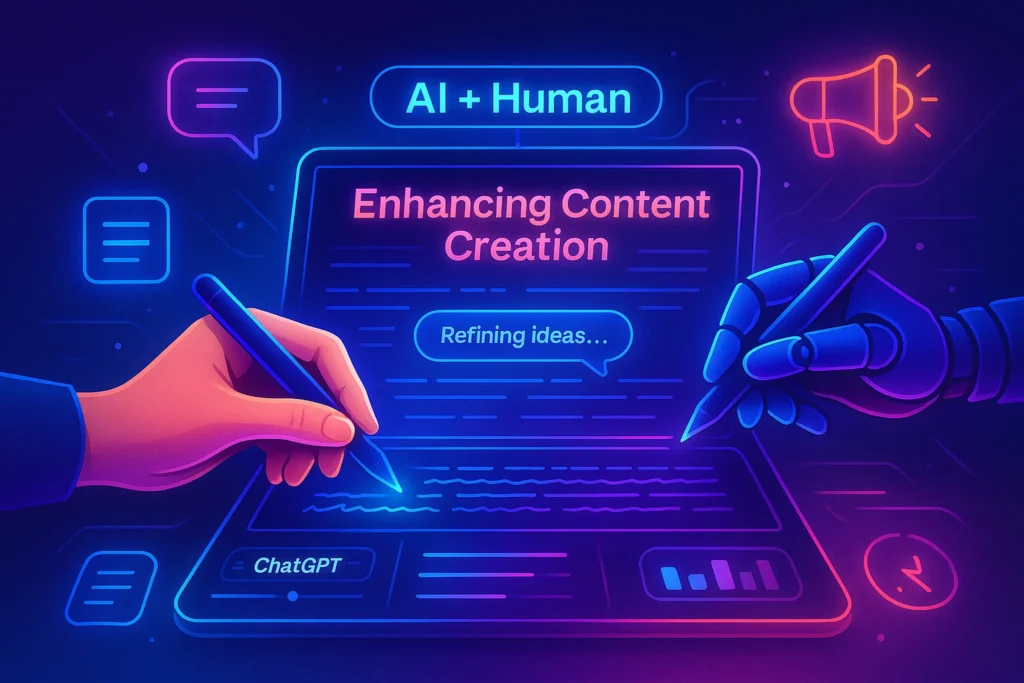🚀 Intro: AI Writing Isn’t About Laziness—It’s About Leverage
If you still think using AI to write is “cheating,” you’re already falling behind.
Modern tools like ChatGPT have evolved from experimental assistants to powerful creative partners—ones that can help you think faster, write smarter, and publish more effectively across platforms.
But using AI effectively isn’t just about dumping a prompt and copying the output. The real power lies in learning how to collaborate with the tool—prompt it like a strategist, edit like a pro, and blend your voice with its speed to craft high-quality content in less time.
This guide will walk you through how to do exactly that—across blogging, copywriting, social media, and more.
🎯 1. Prompting Like a Pro: How to Talk to ChatGPT for Great Content
Garbage in, garbage out. That phrase has never been more true than with AI writing.
A vague prompt like “Write a blog post about email marketing” may give you something technically correct—but flat, generic, and unoriginal.
Instead, think like a director, not a demander. Guide the AI with structure, voice, intent, and audience:
🔑 Better Prompt Example:
“Write a 1200-word blog post on ‘email marketing strategies for SaaS startups,’ targeting early-stage founders. Use a friendly but expert tone. Include 3 case study examples and a CTA for a free email template.”
Notice how this tells the AI:
-
✅ What to write
-
✅ Who it’s for
-
✅ How it should sound
-
✅ What to include
📌 Bonus Tip: Layer your prompts. Start with an outline, then build section by section. This modular prompting gives far more control—and higher quality.
For more hands-on guidance, our in-depth walkthrough on How to Use ChatGPT to Write a Blog Post breaks down every stage of prompt iteration and refinement.
Unlock the AI Edge in Your Content
🧠 Want Better Prompts, Faster Drafts & Smarter Content?
Join our weekly AI Content Brief and get:
🔹 Exclusive prompt frameworks and tone-matching strategies
🔹 Walkthroughs for AI + Human hybrid workflows
🔹 Copy-ready templates for blogs, emails, and social content
Subscribe now and start writing with leverage
🔐 100% privacy. No noise. Just value-packed content tips from NerdChips.
🧠 2. Human + AI: Crafting a Voice That Sounds Like You
One of the most common critiques of AI-generated writing? It sounds robotic or “off.”
That’s because AI mimics language, not intention. It doesn’t have opinions, values, or emotional context—unless you guide it.
Here’s how to fix that:
✅ Add Personal Context to Your Prompts
Instead of “Write a cold email,” try:
“Write a cold outreach email as a freelance designer introducing yourself to a startup founder. I want it to feel personal, not salesy. Mention shared interests like remote work and clean UI design.”
✅ Use “Insert Tone” Tags
Ask the AI to rewrite its own paragraphs:
“Rewrite this paragraph in a conversational tone, like a friendly LinkedIn post—not like a formal article.”
✅ Inject Your Own Stories
Even if the AI gives you a solid base, insert your own metaphors, experiences, analogies—these are the human touchpoints algorithms can’t fake.
This mix of AI speed + human color is what elevates average content into memorable work.
You’ll see the same principle applied in our comparison of top tools in Best AI Writer Tools for Digital Marketers, where we show which platforms allow more control over tone and brand voice.
📲 3. Use Cases Beyond Blogging: How ChatGPT Helps Across Content Types
While blog posts are a common use case, AI shines far beyond the world of long-form articles. Here are just a few real-world examples of where ChatGPT elevates other content types:
🔹 Social Media Posts
AI can help brainstorm tweet hooks, turn a blog post into a carousel, or repurpose a YouTube script into TikTok captions.
🧠 Example Prompt:
“Summarize this blog post into 3 Twitter threads, each with a different hook and a CTA that leads to my newsletter.”
Want a full workflow for AI-assisted social strategy? Don’t miss our roundup in AI Writing Tools, which covers how marketers are using these tools in real campaigns.
✉️ Emails and Newsletters
ChatGPT excels at writing welcome emails, promotional offers, and even onboarding sequences—especially when you feed it prior brand tone and reader context.
🧠 Example Prompt:
“Write a welcome email for new subscribers to my productivity newsletter. The tone should be warm, witty, and helpful. Include one tip and a link to my top free resource.”
Use it to overcome blank-page anxiety, then revise for tone.
💡 Landing Page Copy & Product Descriptions
Many founders use ChatGPT to generate rough drafts of landing pages, which are then polished by a human marketer.
🧠 Example Prompt:
“Write a landing page for a new AI-powered to-do list app that targets busy startup founders. Emphasize simplicity, automation, and stress reduction.”
You can even ask the AI to A/B test versions:
“Give me 3 variations of that above hero section: one value-focused, one emotional, one testimonial-led.”
We break this further in Best AI Writing Assistants for YouTube Scripts, where you’ll also see how AI drafts intros, hooks, and callouts with conversion focus.
Try These Right Now
⚡ Quick Prompt Library: AI You Can Use Today
🔹 “Turn this blog post into a 4-slide Instagram carousel with emotional hooks.”
🔹 “Draft a cold outreach email that sounds informal but confident—like a creator reaching out to a podcast host.”
🔹 “Give me 5 tweet hooks for a YouTube video on productivity apps.”
🔹 “Write a product description in the tone of Apple, but for a budgeting app.”
🔹 “Turn this listicle into a witty landing page for Gen Z users.”
📌 These prompts aren’t magic—but they help you move from blank page to actionable draft in seconds.
🛠 4. Editing & Personalization: Where Human Skill Still Wins
No matter how good AI gets, editing is where your edge lives.
Think of ChatGPT as your first draft assistant, not your final voice. Here’s how to use editing to make AI content truly yours:
✂️ Prune the Redundancy
AI tends to repeat phrases and over-explain. Trim fluff and combine redundant sentences.
🔄 Reshape Structure
Move sections around to build stronger narrative flow or match your platform’s audience expectations.
✏️ Swap in Human Details
Use your own product names, client testimonials, or cultural references to ground the content in real-world credibility.
This editing skill is especially valuable when working with multiple tools. If you’re choosing between AI tools with different tone outputs, check out our side-by-side comparisons in How to Rank in 2025, where we test AI-generated SEO drafts.
⚡ 5. Speed + Quality = The Real Superpower of AI Writing
The real value of AI isn’t that it “writes for you”—it’s that it helps you get to good ideas faster.
By offloading the mechanical parts of writing—brainstorming angles, drafting headlines, building outlines—you free your brain to do what it does best: craft strategy, empathy, voice, and insight.
Here’s a sample workflow to unlock peak content velocity:
-
🧠 Use AI to generate 5–10 headline or hook ideas
-
✍️ Pick 1–2, then prompt a rough outline and base draft
-
🎨 Edit and inject personal tone, data, and narrative
-
🔁 Repurpose into tweets, carousels, email snippets, and more
This loop turns a single idea into multi-format output—without burnout.
And if you’re juggling multiple tools, check out our Ultimate List of Must-Have Apps for Digital Nomads, where we cover complementary tools that sync well with ChatGPT in remote workflows.
🧪 Real-World Examples: Before & After with ChatGPT
Sometimes the best way to understand AI’s impact is to see it in action. Below are a few quick examples of how ChatGPT can transform raw prompts into usable content—once properly guided and edited.
✍️ Before:
“Write a tweet about productivity.”
🪫 Output:
“Productivity is the key to success. Stay focused and work hard.”
✅ After Better Prompt + Edit:
Prompt:
“Write a tweet about productivity for startup founders who work remotely. Add a relatable insight and a specific tip.”
Output (edited):
“You don’t need a 4am routine to be productive. You need clarity. Every remote founder should start their day by writing down the one task they can’t afford to avoid. Everything else flows from there.”
📧 Before (Email CTA):
“Sign up for our newsletter for more tips.”
✅ After:
“Want smarter content strategies delivered without the fluff?
Join 1,500+ creators who get our weekly Brief—one high-signal idea every Sunday.”
🎯 These small edits, layered over AI-generated drafts, make all the difference in tone, resonance, and results.
🧠 The 3-Layer AI Writing Workflow
To truly unlock the potential of AI-assisted content, treat your process like a layered system—not a one-off transaction.
Here’s a practical framework:
1️⃣ Input Layer (You) – Craft clear, contextual, intent-rich prompts
2️⃣ AI Layer (ChatGPT) – Generate first drafts, headlines, outlines, or variants
3️⃣ Human Layer (You again) – Curate, shape, inject tone, add story, and validate facts
Think of ChatGPT as your brainstorming and drafting engine, not your final voice. The most effective creators don’t just use AI—they structure it.
📊 From Prompt to Performance: Real ROI from AI Content
Using ChatGPT isn’t just about saving time—it’s a content leverage model.
Studies and anecdotal data from indie creators and lean teams show:
-
⏱️ 2× to 4× faster content production cycles
-
💸 30% to 50% cost reduction in outsourced content needs
-
♻️ 6–8 format repurposing from a single AI-assisted draft
-
🎯 Higher creative output without burnout
For startups, freelancers, and solo marketers, this is more than a productivity hack—it’s a scalable advantage.
🔐 Ethics & Disclosure: Should You Tell People AI Helped?
This is one of the most debated aspects of AI writing: Do you disclose when content was AI-assisted?
The short answer: it depends.
If you’re using AI to brainstorm, outline, and draft—but you’re still editing, validating, and aligning the final content with your voice—then you’re still the creator.
However, for client work, sponsored content, or sensitive industries (like health, finance, or education), transparency can build trust. Some choose to use subtle disclosures like “AI-assisted,” while others let their editorial rigor speak for itself.
🧠 The key is intention. Use AI to enhance—not replace—your judgment, ethics, and responsibility as a communicator.
🧠 Nerd Verdict
Using ChatGPT to elevate your content isn’t about outsourcing creativity—it’s about upgrading your writing process with a force multiplier.
It gives you speed when you’re tired, structure when you’re stuck, and volume when you’re scaling. But the soul of great content still comes from you—your values, your stories, your human insight.
When you combine those with AI’s output, you don’t just create faster.
You create better.
❓ FAQ: Nerds Ask, We Answer
💬 Would You Bite?
What’s your biggest friction point when writing content?
Idea generation, editing, consistency—or something else entirely?
Tell us below 👇 and let’s train the AI (and our workflow) to work even better for you.



